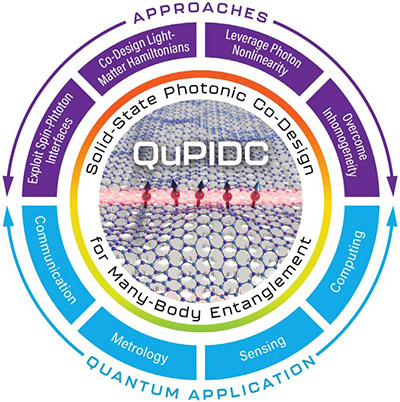Technical summary

Photonic platforms based on solid-state materials present a promising path toward the scalable generation of complex quantum states of light, which are essential for the development of quantum networks, entanglement-enhanced metrology, and optical quantum computation. The key enabler of these technologies is the efficient and reliable generation of quantum light. Solid-state quantum emitters—including defects, quantum dots, molecules, and two-dimensional (2D) materials—have demonstrated significant potential for generating quantum light, while advances in nanophotonic structures have made it possible to manipulate light at the chip level.
However, despite the progress, significant scientific challenges remain, particularly regarding scalability. Inhomogeneities and dephasing, which are inherent to solid-state systems, have limited the generation of quantum light to small photon numbers. Addressing noise channels, such as decoherence and inhomogeneity, is essential for advancing quantum photonic systems. Moreover, new strategies are required to generate and characterize robust, many-photon entangled states in the presence of imperfections.
The Quantum Photonic Integrated Design Center (QuPIDC) aims to systematically address these challenges by leveraging the complexity and imperfections of solid-state materials to discover, design, and realize robust many-body entangled photon and matter states. This will be achieved through a multi-scale co-design strategy that integrates solid-state quantum emitters with advanced nanophotonic structures. The QuPIDC team is uniquely equipped for this mission, with expertise spanning solid-state quantum emitters, nanophotonics, materials growth, quantum optics, ultrafast spectroscopy, and quantum many-body dynamics.
QuPIDC’s Goals
Over the next four years, QuPIDC will pursue three primary goals:
- Co-design Quantum Emitters and Nanophotonic Structures: The center will integrate quantum emitters with nanophotonic structures to reduce decoherence, increase photon collection efficiency, and enable control over spin and polarization. This integration will also enhance nonlinear interactions crucial for generating quantum light.
- Prepare Entangled Photon and Emitter States in Inhomogeneous Systems: Using Hamiltonian engineering and quantum control strategies, QuPIDC will generate entangled states of photons and emitters within complex, inhomogeneous systems. This approach will allow the creation of robust quantum states despite intrinsic material imperfections.
- Develop New Theoretical and Experimental Tools: QuPIDC will create innovative theoretical frameworks and experimental techniques to identify, generate, and characterize complex quantum states of light and matter. These tools will be essential for realizing many-photon quantum states that are resilient to noise and loss.

